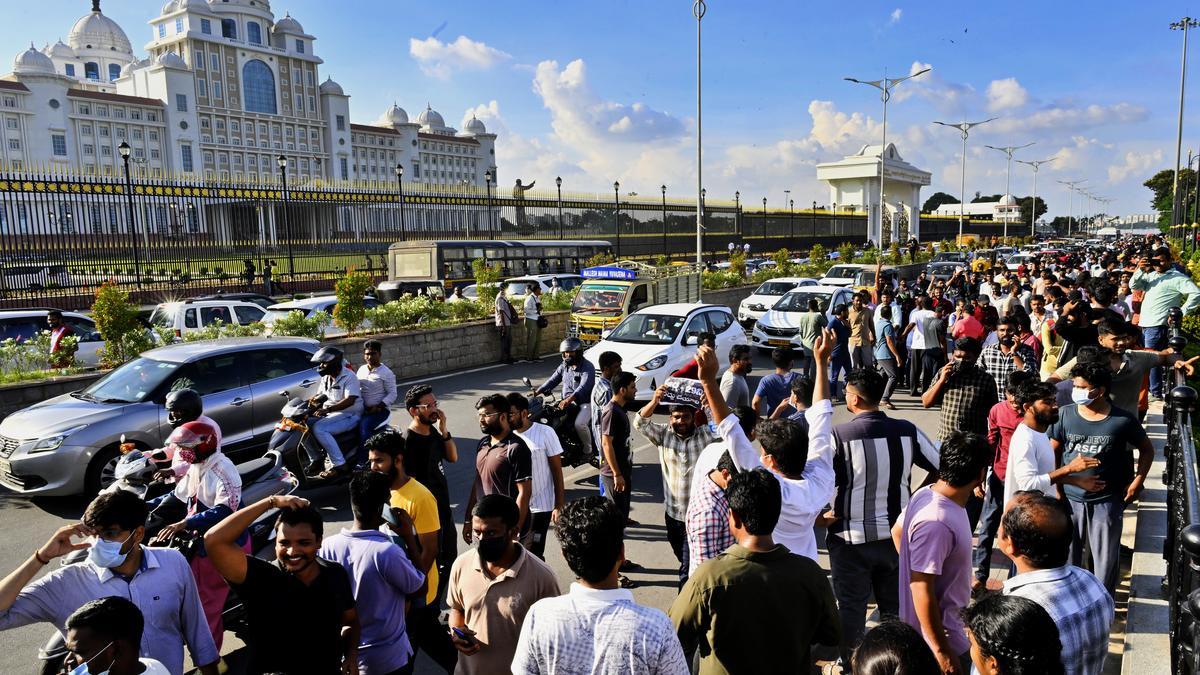
When hope meets hurdles: stark reality of Telangana’s job market Premium
The Hindu
Unemployed youth in Telangana protest for job opportunities, highlighting the struggle for government jobs in the state.
On October 17, the simmering anger among Telangana’s unemployed youth spilled onto the streets of Hyderabad, as they blocked traffic in the city’s central part, chanting slogans and demanding postponement of the Group-I exams slated to begin from October 21. The young demonstrators made their way to the Secretariat — the epicentre of Telangana’s administration — even as confused motorists watched the scene unfold. Armed with A4-sized print-outs bearing messages of justice, the protestors wove through the vehicles, highlighting the gap between the government’s assurances and the harsh reality that job seekers face.
Among the protestors was 24-year-old K. Nagender from Warangal. “The BRS government hired 1,60,000 persons. The present Congress government is giving out appointment letters to people for jobs whose notification was given by BRS, exams conducted by the BRS,” says Nagender, an Osmania University student, who created a reel about the failures of the Congress regime.
The protests in October were preceded by a series of protests by job aspirants in Ashoknagar and Chikkadpally area. A few weeks earlier, aspirants for teaching jobs staged a similar protest at the same location, demanding the postponement of the District Selection Committee (DSC) exams. The protests captured the discontent among young men and women for whom State government jobs seem increasingly elusive, almost like a mirage.
The hunt for jobs has been central to Telangana’s identity and its struggle for statehood. The movement for a separate Telangana took root in 1969 when Annabattula Ravindranath initiated a hunger strike over the hiring policies at the power plant in Kothagudem, then newly-established. Five decades later, even as the disused chimney stacks of that plant were dismantled for safety, the battle for employment opportunities in Telangana continues, albeit with a new twist.
James, a graceful and soft-spoken youth, makes every visit to Feranoz restaurant in Hyderabad’s Jubilee Hills an experience to remember. Hailing from Lamka Town in Manipur, nearly 2,872 kilometres away, the 25-year-old secured a job as a server at the newly opened café through the WorkIndia app, a free platform that connects job seekers with employers.
“I used to work in Goa but moved to Hyderabad for better job prospects. My sister also works here,” he shared during the café’s inauguration. James is not alone; six other individuals from Manipur have also found work at Feranoz, working alongside colleagues from West Bengal, Odisha, and Telangana.
For several youth like James, Telangana offers diverse opportunities that attract workers from various states across the country. Take the example of Subhan Khan, a youth from Mewat in Haryana who displayed extraordinary courage during the September floods in Khammam district. Driving an earthmover over a bridge amid raging waters, he rescued nine people who were stranded, showcasing not just bravery but also skill.

According to the historians, the kingdom was marred by internal strife for power. Despite several hurdles, Ahmad Shah I created an environment that attracted scholars from around the world. Besides promoting art and literature, the Mahmud Gawan Madrasa -an educational institution was established during his rule.

It will comprise 24 sessions across two days and host over 70 speakers from around the globe representing diverse aspects of mentoring to “create a vibrant and connected youth mentoring community that drives evidence-based, innovative mentoring models in the country,” as the release puts it. Some key themes that will be addressed include mentoring and educational policy, designing quality mentoring programmes, decoding the global evidence around youth mentoring, innovations in mentoring etc.









